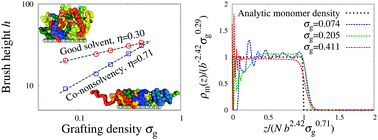Many-chain effects on the co-nonsolvency of polymer brushes in a good solvent mixture†
Abstract
Polymer brushes normally swell in a good solvent and collapse in a poor solvent. An abnormal response of polymer brushes, so-called co-nonsolvency, is the phenomenon where the brush counter-intuitively collapses in a good solvent mixture. In this work, we employed molecular dynamics simulations to investigate the structural properties of the grafted polymers in the occurrence of co-nonsolvency. Brushes with various grafting densities were considered to study the effect of topologically excluded volumes on the co-nonsolvency. We found that the brush height follows a novel scaling behavior of the grafting density h ∼ σg0.71 in the co-nonsolvent mixture. Using the scaling exponent and Alexander-de Gennes theory, an analytic function that predicts the monomer density was obtained. The many-chain effects in the co-nonsolvent lead to the formation of both intermolecular and intramolecular bridging structures. Increasing the grafting density entails lower looping events occuring because of the intermolcular bridging, causing diverse structural properties. We report how the average thickness, the polymer orientation, and the looping probability vary as the grafting density increases. Based on these observations, we constructed a phase diagram of the polymer brush system using the average thickness and orientation as order parameters. Our simulations and analytical results reveal the nature of co-nonsolvency in polymer brushes in an explicit way and will help to provide practical guidelines for applications such as drug delivery and sensor devices.



 Please wait while we load your content...
Please wait while we load your content...